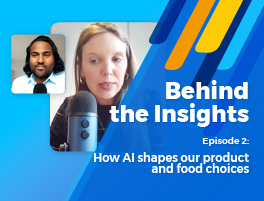Behind the Insights episode 4
Who’s driving the research behind emerging technologies?
This is Behind the Insights, a vodcast series by MetrixLab. We talk to experts from all over the world to find out what’s really driving today’s hottest topics in insights.
In this episode, join MetrixLab client director JJ Szymanski and General Motors research principal Shirley Ng as they discuss how customers shape the research behind new technologies.
Check it out and stay tuned for new episodes every month.
Or if you prefer, read the full transcript below.
Episode transcript:
JJ: Hello, I’m Piotr JJ Szymanski, I’m a client director with the MetrixLab office in Singapore, and it’s my real pleasure to have today with me, Shirley Ng from General Motors.
Shirley: And hello, JJ, thanks for inviting me. My name is Shirley Ng, I’m the research principal of GM International, currently based in Shanghai.
The focus of my work is mainly in the global product development, working with internal teams such as design and product planning groups. My work focuses on North Asia, Asia Pacific, Middle East, including North Africa, Australia, Europe and also Russia in both luxury and in mass segments of the auto industry. And I’m really happy to be here.
From data to consumers to agencies: It’s all about trust
JJ: Not only that, your role spans a large part of the world, but you’ve been in the industry for quite a while, which makes you a perfect source of wisdom on how our insights industry has been changing.
How do you see the past versus today’s research challenges and how would you expect in terms of challenges of the future?
Shirley: I see a lot of challenges and change, you know, from, let’s say, 10 years ago, 15 years ago, and what we’re facing today. But one of the I would say the biggest research challenge we face today has to deal with the volume of data and the breadth of it and the varieties of data that can be, you know, downloaded, can be read, you know, by our customers and us internally.
And I would say that, you know, the word is just data trust, I would say, is one of the biggest challenges we face today. And trust is built over time – internally in a company and also externally with your customers.
So internally, trust in the use of data is when a data point is well put together. And it provides insights that helps internal stakeholders build a better product. And that the feedback from the external voices and from the customers and from the market trends are insightful.
So technical expertise, you know, within a company definitely has a lot to do with trust. And sure, unintended mistakes can be made. And the point is that you don’t repeat those mistakes, right? So in another word, we have to become a reliable compass in our company with this vast volume of data that we are reading.
Now externally, we communicate with customers on topics such as the vehicles’ capabilities in what we promise to deliver. And this capability is a conclusion of many years of research. Just make sure that you know, what you have promised to deliver to the customers is what the market sees.
And let’s talk about EVs and autonomous features today. And that is generating a lot of excitement, definitely. And anyone can search for information easily from their mobile phones and their devices. The thing is, we do not know what information customers are reading today.
And messages that we distribute might conflict with some of the materials that customers are reading. So moving forward, this is something we need to deal with. It’s not going to go away. And it’s definitely different from what we used to have to deal with.
And especially for the new technology, data and method we communicate. So this is what I see as the biggest challenge moving forward. It’s just going to get, you know, more complex. The data source is going to get wider, not narrower.
And it’s something that we need to manage. Today.
JJ: OK, so new challenges, but they all sound familiar. And one thing that doesn’t change is trust. Trust with the data and trust between people, because trust is such a human thing.
Which also sounds familiar and makes me think about how it all started when you and I started working together. I was a new kid on the block at MetrixLab, I had to work hard to build this trust with you.
Step by step, project by project, and sort of using different obvious devices, the most important being transparency and openness, in the in the way we worked. So that is, that definitely sounds familiar not only for the relationship between customers, but also even for the relationship in our insights industry.
Shirley: That’s right. Promise what you deliver. That’s what I see from you. Yeah.
New tech, same consumer focus
JJ: Shirley, you are talking about these fascinating new technologies that are currently emerging. They’re already with us, but developing really fast and I envy you really brushing shoulders with all these fascinating new technologies on a daily basis.
So how do you approach this from an insights and research point of view? What new ways do you need to think of when researching these new technologies?
Shirley: Developing a new vehicle product such as an EV or autonomous features inspires excitement, that’s for sure.
And the new technology developments, such as, you know, an active safety features or a new vehicle design, a new EV design, it still requires a highly disciplined research process. Internally, you know, you go through the same approval steps and review gates, right?
That does not change from the past work process as if you’re working on an ICE vehicle. What has changed today is meeting customers’ high expectations and reaching internal investment goals. The balance of the both. And global trends have changed. We understand, you know, that the contents are getting more complex and with faster implementations of the new technologies. As a manufacturer, we need to provide a balanced product, you know, to new vehicle buyers. We do not want to under package a content offer and miss the opportunity to deliver satisfaction. And our customers are asking a lot more, I would say.
They are asking a lot more from, you know, work that we have done in the past 15 years ago. So, on the other hand, we don’t want to over offer either. And that’s when we over-invest in a package with items that are not a priority to the buyers, you know, per the price that they want to pay. And that’s when the balance is tipped. So manufacturers want a balanced offer where the content meet the customer’s desires, and at the same time, we are not over-invested.
Now, this balance of the new items that’s being offered, you know, that’s become much more complex than in the past. But it still requires, as I have said before, you know, the same disciplines, you know, as we investigate step by step.
So some things have changed. Some things do not change, you know, just because we are working on new technologies. But the way we investigate, you know, has changed, I would say. But the steps are the same.
JJ: The thing I’m glad about is that you say that one element doesn’t change in the whole picture, which is that insights is still the people’s business. And that’s great.
Shirley: Yes. And I would close this by saying that, you know, just because it’s new and it’s exciting, it doesn’t mean that, you know, you can skip certain investigations. The same work habits, the discipline does not go away whether you’re working on an autonomous or an EV or an ICE.
JJ: Thank you, rigor and quality. That’s a great wrap up. Thanks, Shirley.
Shirley: Thank you.








